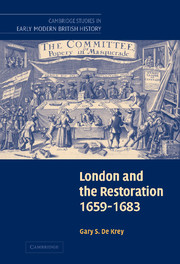Book contents
- Frontmatter
- Contents
- List of figures
- Map
- List of tables
- Preface
- List of abbreviations
- Part I Crisis, 1659–1660
- Part II Settlement and unsettlement, 1660–1679
- 2 The Restoration settlement and an unsettled city, 1660–1670
- 3 Protestant dissent and the emergence of a civic opposition, 1670–1679
- Part III Crisis, 1679–1682
- Part IV Crisis and conspiracy, 1682–1683
- Conclusion: London and the end of the Restoration
- Appendices
- Appendix I 1670 London dissenting subscription
- Appendix II London dissenting common councilmen, 1669–1671
- Appendix III Whig party leaders
- Appendix IV Tory party leaders
- Bibliography
- Index
- Titles in the series
2 - The Restoration settlement and an unsettled city, 1660–1670
Published online by Cambridge University Press: 07 May 2010
- Frontmatter
- Contents
- List of figures
- Map
- List of tables
- Preface
- List of abbreviations
- Part I Crisis, 1659–1660
- Part II Settlement and unsettlement, 1660–1679
- 2 The Restoration settlement and an unsettled city, 1660–1670
- 3 Protestant dissent and the emergence of a civic opposition, 1670–1679
- Part III Crisis, 1679–1682
- Part IV Crisis and conspiracy, 1682–1683
- Conclusion: London and the end of the Restoration
- Appendices
- Appendix I 1670 London dissenting subscription
- Appendix II London dissenting common councilmen, 1669–1671
- Appendix III Whig party leaders
- Appendix IV Tory party leaders
- Bibliography
- Index
- Titles in the series
Summary
INTRODUCTION: SETTLING THE CHURCH, 1660–1665
None of the issues confronted by king and kingdom in 1660 would prove more divisive than that of church settlement. The irenic spirit that brought Presbyterians and Anglicans together in the city of London and in many counties in 1659–60 was genuine, but it was also founded on the common fear of the sects. As the sects were subdued, Anglicans and Presbyterians discovered they feared each other as much as they feared the opponents of monarchical and parochial structures in church and state. Presbyterians hoped to preserve as much as possible of the reformation of the 1640s in the restored church; but Anglicans sought instead to return the church to its pre-1642 hierarchical orders, forms, and patterns. As Anglican royalists gained the upper hand in the country and in parliament, they imposed their church settlement on Reformed Protestants, on the city, and on the king himself. The result was a rigidly episcopal national church that was exclusivist in its personnel and uncompromising in its practice. Reformed Protestant parochial clergy were given the choice of conformity or expulsion. The restored church was also anchored on the magistrate's sword: new statutes forbade worship outside the established order, under various pains, and even regulated the place of residence of expelled clergy.
The Anglican royalist church agenda was, however, constructed upon two unrealistic expectations that reflected the pre-revolutionary world of the early Stuart ecclesia.
- Type
- Chapter
- Information
- London and the Restoration, 1659–1683 , pp. 69 - 115Publisher: Cambridge University PressPrint publication year: 2005



